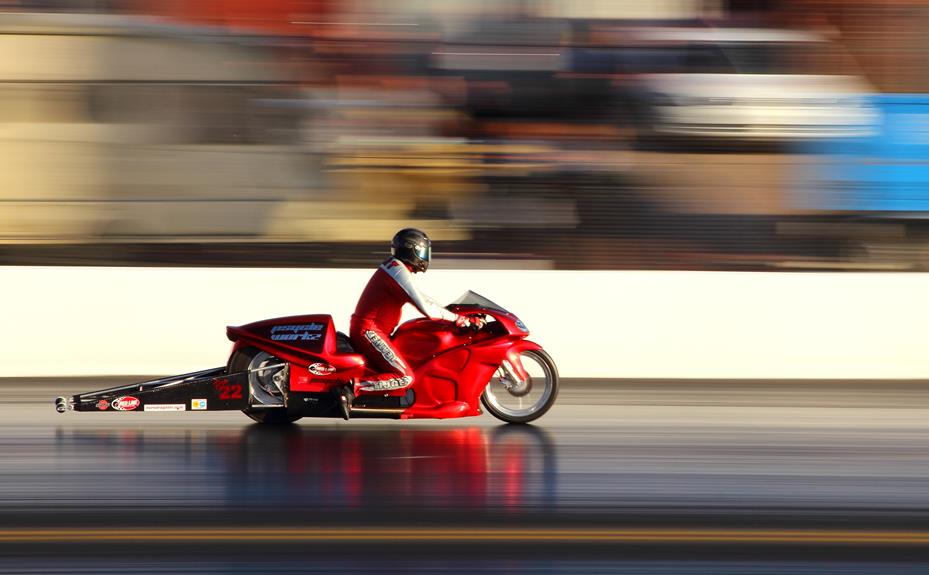Ultimate Traction: Choosing the Right Drag Racing Slicks
Just as a painter needs the right brush to create a masterpiece, a drag racer requires the perfect slicks for ultimate traction. This article illuminates the science behind drag racing tires, explores various types, deciphers specifications, and emphasizes the significance of proper inflation. It will guide you in correlating track conditions with tire choice, provide maintenance tips, review top brands, and assist you in your final decision – choosing the right drag racing slicks for freedom on the track.
Key Takeaways
- Slicks offer unparalleled traction crucial for split-second performance differences
- Well-chosen slicks and aligned wheels can lead to exceptional performance
- Different types of drag racing slicks provide advantages based on their design and compound
- Proper tire inflation is important for speed, safety, and tire longevity in drag racing.
Understanding the Role of Slicks in Drag Racing
In the intricate world of drag racing, slicks play a pivotal role, offering an unparalleled level of traction that is crucial for the split-second performance differences that can determine victory or defeat. These high-performance tires, specifically designed for the sport, are devoid of treads and boast a broad, flat surface. This unique design maximizes the contact area between the tire and the track, thereby significantly augmenting traction.
However, the performance of these drag racing slicks is not solely reliant on their design. Wheel alignment is an equally essential aspect to consider. Improper alignment can lead to uneven tire wear, reduced traction and ultimately, compromised performance. A carefully calibrated alignment ensures that the tires are precisely parallel and perpendicular to the ground, thereby optimizing their grip on the track.
Understanding the role of slicks in drag racing is liberating as it empowers you to make informed decisions. A well-chosen slick, coupled with perfectly aligned wheels, can be your ticket to an exceptional performance on the track. Remember, every fraction of a second counts in this sport, and the right slicks can make all the difference.
The Science Behind Drag Racing Tires
While one might assume that drag racing tires are simply about maximum surface contact, the science behind these high-performance slicks involves a complex interplay of factors, including rubber composition, tire pressure, and temperature.
The rubber composition is a strategic blend of natural and synthetic materials that provide the perfect balance of grip and durability. Tire pressure is critical in distributing the car's weight evenly across the tire surface for maximum traction. Temperature too plays a vital role, as heat increases the tire's stickiness, enhancing the grip on the race track.
Lightweight wheels and wheel spacers are integral to the tire's performance. Lightweight wheels reduce the overall weight of the vehicle, enabling faster speeds. Wheel spacers, on the other hand, improve the car's handling by increasing the distance between the wheels.
Here's an analysis of the role of these components:
| Component | Function |
|---|---|
| Lightweight wheels | Reduce vehicle weight, enhancing speed |
| Wheel spacers | Improve handling by increasing wheel distance |
Different Types of Drag Racing Slicks
There are several distinct types of drag racing slicks, each designed with a specific set of conditions and requirements in mind, and understanding their differences is crucial for making an informed choice.
- Bias Ply Slicks: Traditional in design, these tires flex during a launch, providing a broader footprint for better traction. They are best suited for vehicles with manual transmissions.
- Radial Slicks: Radials feature a stiffer sidewall and are advantageous in vehicles with automatic transmissions or those equipped with drag racing suspension components.
- Slick Widths: Wider slicks deliver a larger contact patch, thus more traction. However, the choice must account for the vehicle's horsepower and weight to prevent over-tire situations.
- Soft vs Hard Compound Slicks: Soft compound slicks provide superior grip but wear quicker. Hard compound slicks, on the other hand, are more durable but may not deliver the same level of traction.
Knowledge of these types liberates you from uninformed decisions and empowers you to select the right slick for your racing needs. Let's now delve into the science behind these choices and decode tire specifications: size, width, and compound.
Decoding Tire Specifications: Size, Width, and Compound
A racer's understanding of tire specifications, including size, width, and compound, is essential, and mastering this knowledge can significantly improve performance on the drag strip. Each tire specification serves a unique purpose: size for fitment, width for traction, and compound for grip.
| Specification | Description | Importance |
|---|---|---|
| Size | Diameter and width of the tire | Ensures correct fitment on the vehicle |
| Width | Broadness of the tire's tread | Enhances traction on the racing surface |
| Compound | The blend of materials in the tire | Determines grip and durability |
The size of the tire is crucial for ensuring a proper fit on your vehicle. Too large, and it may not fit the wheel well; too small, and it may not provide sufficient traction. Width is directly related to traction—the wider the tire, the larger the contact patch with the racing surface. The compound, a blend of materials like rubber and synthetic polymers, affects the tire's grip and durability. The right compound can help the tire adhere to the track, providing stability during high-speed runs.
Understanding these specifications is an empowering step towards optimizing your vehicle's performance. Let's now turn our attention to the importance of proper tire inflation in drag racing.
Importance of Proper Tire Inflation in Drag Racing
Optimal tire inflation is a critical factor in drag racing, affecting both a vehicle's speed and its safety on the track. The correct pressure directly influences the tire's contact patch with the ground, thus determining the level of traction. Understanding the implications of inflation on performance will enable racers to make informed decisions, striking a balance between speed and safety.
Inflation's Impact on Performance
Understanding the profound influence of tire inflation on the performance of a drag racing vehicle is central to achieving optimal traction and speed.
- Tire Pressure: Crucial in determining contact patch, the area of the tire touching the track, affecting traction.
- Heat Management: Proper inflation aids in heat dissipation, crucial for maintaining grip and tire longevity.
- Stability and Control: Correct inflation ensures stability at high speeds, reducing the risk of dangerous tire blowouts.
- Fuel Efficiency: Over or under-inflation can cause drag, negatively impacting fuel efficiency and overall performance.
These factors underline the importance of monitoring and adjusting tire pressure meticulously. As we transition into the subsequent section, 'balancing speed and safety', we'll explore how proper tire inflation plays a role in ensuring both.
Balancing Speed and Safety
Striking a balance between speed and safety in drag racing hinges greatly on the precision of tire inflation, a factor that can significantly influence the vehicle's performance and the driver's control. Properly inflated tires ensure optimal traction, essential for rapid acceleration and high-speed stability. Over-inflation reduces the tire's contact patch with the track, compromising traction and control. Conversely, under-inflation increases the contact patch but decreases stability, risking tire damage due to excessive sidewall flexing. Accurate tire pressure monitoring and adjustments are crucial to maximize both speed and safety. Tire inflation must be considered in conjunction with other factors like track conditions, ambient temperature, and driving style to achieve the perfect balance. In drag racing, the right tire inflation isn't just about speed—it's about survival.
The Influence of Temperature on Drag Racing Slicks
During the course of a drag race, the temperature can significantly affect the performance of your slicks, thereby influencing the overall traction and speed of your vehicle. Understanding the interplay between temperature and tire performance is paramount for racers seeking to optimize their speed while maintaining control.
Four key temperature-related factors that impact drag racing slicks are:
- Ambient Temperature: The air temperature can directly affect tire pressure. Higher temperatures lead to increased pressure and potentially reduced traction.
- Track Temperature: Hotter tracks can increase tire grip initially but may lead to tire degradation over time due to excessive heat.
- Tire Operating Temperature: The ideal temperature range for most racing slicks is between 180 and 200 degrees Fahrenheit. Outside this range, traction may decrease.
- Heat Cycles: Each heat cycle hardens the tire compound, which can reduce overall traction.
The Relationship Between Track Conditions and Tire Choice
Understanding the interplay between track conditions and tire selection is essential for drag racing success. The condition of the track, whether it's temperature, surface material or moisture level, directly influences the performance of different tire types. Thus, a strategic choice of slicks, based on these conditions, can significantly optimize traction and reduce race times.
Assessing Track Conditions
One must carefully evaluate the prevailing track conditions, as they significantly influence the selection of appropriate drag racing slicks. Understanding the relationship between track conditions and tire choice is critical to achieving ultimate traction and optimum performance.
- Track Temperature: High temperatures can make the track slick, requiring tires with a softer compound for better grip. Conversely, cooler temperatures may necessitate harder tires.
- Surface Texture: Rough surfaces demand durable, tough tires, while smoother tracks benefit from softer, more adhesive tires.
- Moisture Level: Wet tracks require tires with deeper grooves to channel away water and prevent hydroplaning.
- Track Material: Different materials, like asphalt or concrete, have varying levels of inherent grip, influencing tire choice.
Understanding these factors will guide your tire selection, enhancing performance and granting a liberating sense of control over your vehicle's capabilities.
Tire Selection Impact
The compound effect of tire selection and track conditions significantly influences the overall performance in drag racing. A driver's understanding of this intricate relationship is paramount to optimizing their vehicle's traction and, consequently, their speed. Track conditions such as temperature, humidity, and surface type greatly affect tire grip. For instance, colder temperatures harden tire compounds, reducing traction, while warmer conditions soften them, increasing grip. High humidity can make surfaces slick, requiring a softer tire for improved traction. Similarly, surface texture affects tire choice; smooth surfaces necessitate harder tires for durability, while rough surfaces need softer tires for better adhesion. An informed tire selection, cognizant of these variables, can substantially enhance a vehicle's performance, providing the driver with the ultimate control and the freedom to push their limits.
Maintenance Tips for Your Drag Racing Slicks
Several crucial steps exist in ensuring the longevity and optimum performance of your drag racing slicks through regular maintenance. This process is integral to maintaining your competitive edge and ensuring that you consistently achieve maximum traction.
Here are four maintenance tips for your drag racing slicks:
- Regular Inspection: Always inspect your tires for signs of wear and tear, punctures, or any other damage before and after each race. This will help you identify potential problems early and prevent costly tire failures.
- Proper Storage: Tires should be stored in a cool, dry place away from sunlight. Exposure to heat and UV light can degrade the rubber, reducing its performance and lifespan.
- Correct Inflation: Always ensure your tires are correctly inflated according to the manufacturer's specifications. Over or under-inflation can lead to poor performance and premature tire wear.
- Rotation: Regularly rotating your tires will help ensure even wear and extend their lifespan. The rotation pattern should be based on your vehicle's drivetrain configuration and the specific wear patterns observed on your tires.
Top Brands for Drag Racing Slicks
When it comes to achieving maximum traction in drag racing, the choice of slicks is paramount and this often boils down to the brand. In the next section, we will be discussing and comparing the top-ranking brands in the industry, objectively analysing their performance on the drag strip. This will provide a clearer picture of what each brand brings to the table in terms of quality, design, and traction potential.
Comparing Top Brands
Industry-leading manufacturers like Goodyear, Hoosier, and Mickey Thompson dominate the drag racing slicks market, each offering a unique blend of traction, durability, and performance.
- Goodyear: Known for their innovative Eagle drag slicks, Goodyear offers superior traction and heat resistance, thanks to their exclusive compound formulations.
- Hoosier: Hoosier's drag racing tires are praised for their consistency and durability, crucial for racers who need trustworthy performance.
- Mickey Thompson: With their ET Drag slicks, Mickey Thompson promises exceptional grip and improved stability at high speeds, a testament to their advanced tire construction technology.
- Other Brands: Many other brands like Dunlop and Pirelli also offer commendable drag racing slicks. However, their market presence is less dominant but still noteworthy.
Brand Performance Analysis
While Goodyear, Hoosier, and Mickey Thompson are the preferred brands for many professional drag racers, it is essential to conduct a thorough performance analysis to determine the most suitable slicks for your specific racing needs. Goodyear is celebrated for its Eagle Dragway Specials, superb for their heat resistance and durability. Hoosier, on the other hand, is renowned for its D.O.T. Drag Radials, which offer exceptional grip and speed. Meanwhile, Mickey Thompson is acclaimed for their ET Drag Slicks, prized for their consistency and versatility. This analysis should be guided by your vehicle's power, weight, and the track conditions you'll be racing on. Now armed with this knowledge, you're ready to move onto the next section about making the final decision: choosing your drag racing slicks.
Making the Final Decision: Choosing Your Drag Racing Slicks
Often, the final decision in choosing your drag racing slicks is a crucial step that requires careful consideration and comparison of various factors. This pivotal choice can significantly impact your performance and success on the drag strip.
Here are four key factors to consider when making your final decision:
- Track Conditions: Evaluate the typical conditions of the drag strip where you'll be racing. A slick designed for a hot, sticky track may not perform well on a cooler, less adhesive surface.
- Car Specifications: Consider your car's weight, horsepower, and suspension setup. Different slicks are designed to work optimally with different car specs.
- Brand Performance: Reflect on the performance analysis of different brands. Your choice should go beyond brand loyalty and be based on proven track performance and reliability.
- Budget: Although not a performance factor, your budget plays a crucial role in your decision. Expensive does not always mean better. Aim for a balance between cost and performance.
Frequently Asked Questions
What Are the Safety Considerations When Using Drag Racing Slicks?
Safety considerations when using drag racing slicks include ensuring proper tire inflation, regular inspection for wear and damage, using the correct size for your vehicle, and adhering to recommended speed ratings.
How Often Should Drag Racing Slicks Be Replaced?
Drag racing slicks, like soldiers in battle, endure intense conditions and should be replaced every 5-10 races. This depends on wear and tear, performance, and safety inspections, ensuring optimal traction and control.
Can I Use Drag Racing Slicks on Regular Roads?
Drag racing slicks are not recommended for use on regular roads due to their design for maximum traction on race tracks. They lack tread patterns for wet conditions, making them unsafe for street driving.
Is There a Difference in Performance Between Cheaper and More Expensive Drag Racing Slicks?
Yes, there is a performance difference. Higher priced drag racing slicks typically offer superior traction, heat resistance, and durability, contributing to improved performance and potentially better race times compared to cheaper alternatives.
Can Drag Racing Slicks Be Repaired if They Are Damaged or Do They Need to Be Replaced?
Drag racing slicks, if damaged, can sometimes be repaired depending on the severity and location of the damage. However, for optimal safety and performance, replacement is often the recommended course of action.
Conclusion
In conclusion, the selection of the right drag racing slicks is a critical aspect in achieving ultimate traction and optimal performance. Understanding tire specifications, the importance of proper inflation, and the influence of track conditions are all pivotal. Also, regular maintenance and choosing reliable brands can enhance tire longevity. Given that tire choice can impact a drag racer's time by up to 0.2 seconds, the significance of this choice cannot be overstated.







